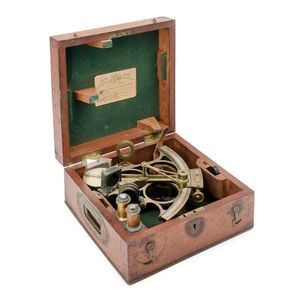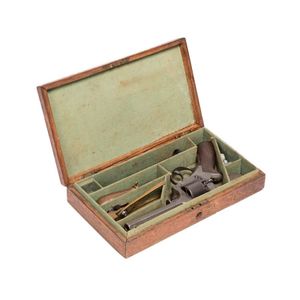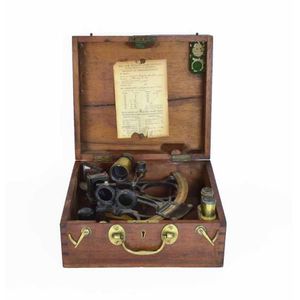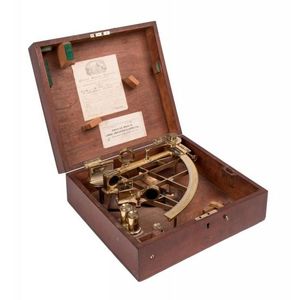A mahogany cased brass sextant, No. 1339 by George Whitbread London, presented to Edward Parker Bedwell. This sextant inscribed 'Presented by Greenwich Hospital to Edw'd Parker Bedwell' is believed to have been presented to Staff-Commander Edward Parker Bedwell Royal Navy (1834-1919). E. P. Bedwell started his naval career as a student at the Greenwich Royal Hospital School, joining on 22nd August 1845, aged 11. Greenwich Hospital was set up some 300 years ago to provide accommodation for Naval Pensioners. There was provision in their deeds for the additional provision of an education for the sons of Naval Pensioners and it was from this that the School was born. Both the Hospital and the School were based at Greenwich. Bedwell's father joined the Royal Navy in 1806 and rose to rank of Lieutenant but received two severe gun-shot wounds while serving in Long Island USA, directly following the blockade of New London in 1814. In consideration of Lieut. Bedwell's wounds he was presented with a gratuity from the Patriotic Fund. Edward Parker Bedwell's studies at the Greenwich Hospital would have specialised in Navigation, and he would have been taught in the 'Upper Nautical' section where he would have learnt astronomy, mathematics and navigation. It's understood from records held by The Royal Hospital School Heritage centre that a Sextant/Octant was presented each year to their top student. Bedwell joined the Navy in 1848, and in 1851 and 1852 he served under Sir William Parker, one of Lord Nelson's captains, fighting in the Crimean War in H. M. S. 'Ardent' and 'Sheerwater'. In 1854, he had the privilege of being personally delivered the news of the key British victory at the Battle of Alma to the Royal Navy's Mediterranean Command in Malta. In 1857, he became a navy surveyor and was sent to chart parts of the rugged coastlines of British Columbia (BC) and Vancouver. Bedwell Bay and Bedwell Harbour in BC both bear his name. He was posted to Australia as Chief Assistant to the NSW Hydrographic Survey in 1864, later taking charge of the Queensland survey. Bedwell continued the survey of Moreton Bay until the beginning of 1868; and from then to 1879 he surveyed the coast between Danger Point and the north end of the Cumberland Islands (near Mackay); the Brisbane, Mary, Burnett and Fitzroy Rivers to their principal townships; plus Port Curtis and Bowen. The coastal survey from Capes Townshend and Palmerston to the Percy Islands (between Rockhampton and Mackay) took four years. The surveying staff transferred from the H. M. S Pearl to the S. S Llewellyn in July 1878. Bedwell reported that the steamer could cover much more ground in less time than the schooner. In 1879 while aboard the Ss Lyewellyn, Bedwell named the islands within the 'Cumberland Isles', which were originally designated by James Cook in 1770. The name Cumberland Islands, which includes the Lindeman Group in the north, the Lindeman Group in the centre and the Sir James Smith Group in the south, is seldom used today, being replaced by the more popular name, The Whitsundays. Most of these islands named by Bedwell had been originally given alpha-numeric designations by Lieutenant Matthew Flinders in 1802 during his circumnavigation of Australia in the HMS Investigator. Bedwell drew many of the names from the metal Smiths trade and the English countryside of Cumberland. Bedwell returned to England from the Queensland survey in 1880, and afterwards served for about three years on H. M. S. Defence, before retiring in 1883.
You must be a subscriber, and be logged in to view price and dealer details.
Subscribe Now to view actual auction price for this item
When you subscribe, you have the option of setting the currency in which to display prices to $Au, $US, $NZ or Stg.
This item has been sold, and the description, image and price are for reference purposes only.
- Mahogany - Mahogany is a dense, close grained red-coloured timber from the West Indies and Central America. It was first imported into Europe in the the early 18th century and its use continued through the 19th century. It was popular for furniture making because of its strength, the wide boards available, the distinctive grain on some boards, termed flame mahogany and the rich warm colour of the timber when it was polished.. The "flame" was produced where a limb grew out from the trunk of the tree, and this timber was usually sliced into veneers for feature panels on doors, backs and cornices.
Some terms used to describe mahogany relate to the country from which it originally came, such as "Cuban" mahogany, "Honduras" mahogany etc. However unless the wood has been tested the names assigned are more a selling feature, rather than a true indication of the timber's origin.
This item has been included into following indexes:




